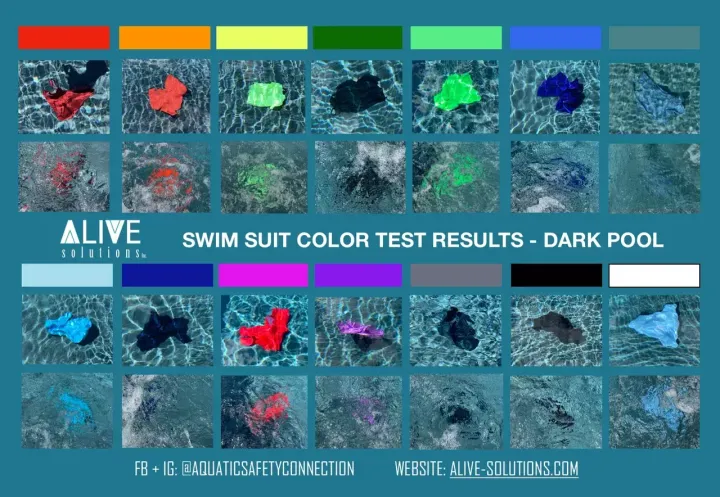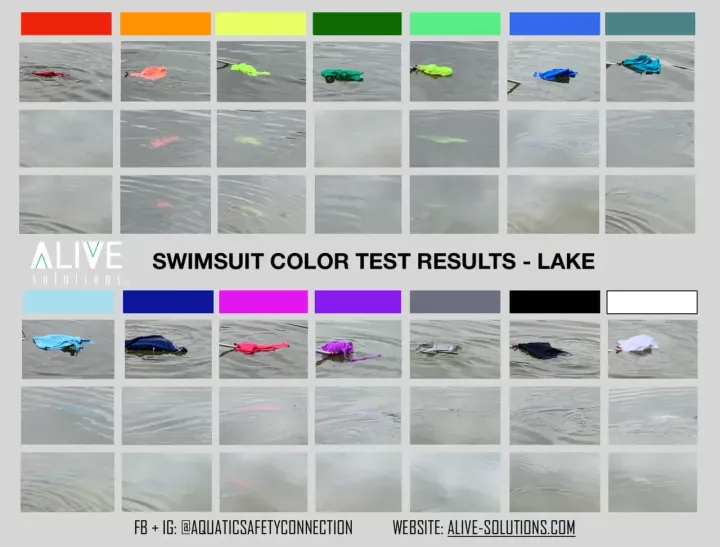Summer means families are more spending time in and around the water: Pool parties, beach days and boat rides are all more common this time of year.
As temperatures heat up, brushing up on water safety is crucial for everyone, but particularly for parents of young kids. According to the CDC, drowning is the second leading cause of death for kids ages 1 to 4.
In addition to educating yourself on drowning prevention (more on that below), there’s a little-known factor to consider when taking your kids swimming this summer — the color of their bathing suits.
Alive Solutions, a company specializing in water safety, conducted an informal study in 2020 to test how visible different colored swimsuits would be in light-bottomed pools, dark-bottomed pools and lakes. For the pools, they tested what the suits looked like underwater (top row) and then again with some surface agitation (bottom row) from the perspective of a person standing on the pool deck.


For the lake, the company tested the different swimsuit colors on the surface of the water (top row), from a shore view (middle row) and from an elevated view (bottom row) to simulate what it would look if the parent were standing on a boat or a dock. The water was only 18 inches deep.
“We do drowning investigations and know that visibility is important in drowning recognition,” Natalie Livingston, co-founder of Alive Solutions, told HuffPost. “As lifeguards and aquatics professionals, we know that there are certain factors that can make someone easier or more challenging to see in the water.”
“Knowing this as our background, we started to look at swimwear for our kids and realized that so many parents were selecting swimwear that was super cute and fashionable, but would cause their children to potentially disappear under the water,” she said.

Neon colors that provide contrast performed the best in both pools and lakes. For light-bottomed pools, neon pink and neon orange stood out the most, while white and light blue suits stood out the least. Dark colors like purple and black could be seen well but are not recommended, as they could be mistaken for dirt, leaves or a shadow.
For lakes and dark-bottomed pools, neon orange, neon green and neon yellow were the most visible. Notably, neon pink did not perform well in the lake setting. White was visible in that environment but could easily be confused for light reflection on the surface of the water, so it isn’t recommended.
“The goal was really to show others how to stay more visible and also how water is challenging to look through. It is not like looking through air,” Livingston said. “Overall, neons came out in the lead in all categories.”
It’s also worth noting that in the lake setting, at two feet of depth, visibility went down to zero for all the colors tested — a good reminder about the importance of wearing life jackets in open-water environments since they keep swimmers at the surface. (Note: Unlike life vests, water wings, tubes, baby circles and other inflatables are not considered safety devices.)
Kids ages 5 and under should also wear life jackets in pools if they’re not protected by “touch supervision,” which means a caregiver is “within an arm’s reach of the child at all times,” according to the National Drowning Prevention Alliance.
The color of your child’s bathing suit is of little importance if other safety measures aren’t being taken.
Mario Vittone, a former Coast Guard rescue swimmer and drowning expert, said that considering the visibility of swimsuit colors in pools is “not a bad idea” and that avoiding white and blue ones is a good call. But he wouldn’t go so far as to say neon-colored suits are “safer.”
“If the color of the suit comes into play, then the drowning has probably already occurred. Being able to easily spot the kid laying on the bottom is good, but it is significantly less good than never letting them get to the bottom in the first place,” Vittone told HuffPost.
“A child in a light blue bathing suit that has had swim lessons and is swimming in a well-guarded pool is an order of magnitude safer than a child in a hot neon yellow suit who hasn’t had swim lessons in a pool guarded by one lifeguard who never takes breaks.”
Indeed, getting your child swim lessons at a young age can reduce their risk of drowning. Make sure you have a good understanding of your child’s swimming abilities — and your own skill level, too.
But as the American Academy of Pediatrics noted, “even advanced swimming skills will not always prevent drowning” and “swimming lessons must be considered only within the context of multilayered protection.”
Constant, careful, undistracted adult supervision is absolutely essential when kids are in and around the water. Drowning happens very quickly — sometimes in a matter of seconds — so even looking away to quickly check your phone or grab a snack can be dangerous.
“Children playing in the water make noise. When they get quiet, you get to them and find out why.”
- Mario Vittone, former Coast Guard rescue swimmer and drowning expert
“Watch — with your eyes — the children in the water, the entire time they are in the water,” Vittone said, while also recommending that adults watch any lifeguards present for about 15 minutes to determine how attentive they’re being.
Having an adult act as the designated “water watcher” is a good idea, too. Just be sure to switch off who’s on duty every 15 minutes or so to give each other breaks and to stay sharp.
“When everybody is watching, nobody is watching,” pediatrician and former lifeguard Dr. Sarah Denny recently told HuffPost. “We see this all the time: A whole group of adults [is] around and a child drowns, and it’s not anyone’s fault, but it’s just [that] everyone assumes everyone else is watching.”
Drowning can be difficult to recognize, so it’s important to know what to look for. It doesn’t look like the thrashing, splashing, yelling-for-help depictions that you’ve seen in movies. As Vittone wrote in a viral post on his website, it’s “almost always a deceptively quiet event.”
“Children playing in the water make noise. When they get quiet, you get to them and find out why,” he wrote.
Look for signs like the child’s head tilted back and low in the water with their mouth open at water level. Other signs include gasping for air, hair covering their face, and eyes that are open, glassy and empty or tightly shut. The swimmer may also look like they’re trying to climb an invisible ladder.
Another important precaution: Add barriers like a four-sided fence with a self-closing and self-latching gate around a pool or hot tub to restrict access.
“If your home represents the fourth side of the pool, make sure you have a door alarm, so you’re alerted if your child leaves the home,” Consumer Product Safety Commission spokesperson Nikki Fleming previously told HuffPost. “In addition, you can also use a pool alarm that will signal an alarm if the child were to actually enter the water.”
Learning CPR can be another life-saving tool to add to your arsenal. When dealing with a drowning victim, experts recommend you start by giving rescue breaths.
“It is not normal, layperson, compression-only CPR,” Livingston said. “Drowning care first starts with air — time without oxygen is critical in the outcome, so giving breaths first is so important.”
You can find trainings in your community or online via the Red Cross and other organizations.
Need help finding a colorful suit? The perfect guide is below.
HuffPost may receive a share from purchases made via links on this page. Every item is independently selected by the HuffPost Shopping team. Prices and availability are subject to change.
Your Support Has Never Been More Critical
Already contributed? Log in to hide these messages.















